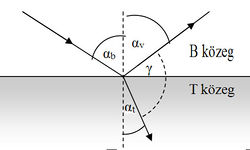Experiments with microwaves
A Fizipedia wikiből
A lap korábbi változatát látod, amilyen Kszasz (vitalap | szerkesztései) 2018. július 3., 12:26-kor történt szerkesztése után volt.
Aim of the experiment
- To deepen the knowledge related to wave phenomena,
- To verify the relationships in wave physics experimentally,
- To model phenomena and devices in wave optics.
For the purpose:
- We summarize the basic knowledge on wave phenomena,
- We examine reflection, refraction, interference and diffraction of microwaves,
- We assemble some experimental setups (which are also useful in optics) based on interference of waves, and measure the wavelength of the used microwave.
Theoretical summary
\setbox0\hbox{\setbox0\hbox{$ 10^{9} - 3 \cdot 10^{11}\ \text{Hz} $}%
\message{//depth:\the\dp0//}%
\box0%
}%
\message{//depth:\the\dp0//}% \box0% </latex>).
Polarization of waves
In a transversal wave the vector related to the changing quantity is in the plane perpendicular to the direction of propagation but within this plane its direction is arbitrary.
